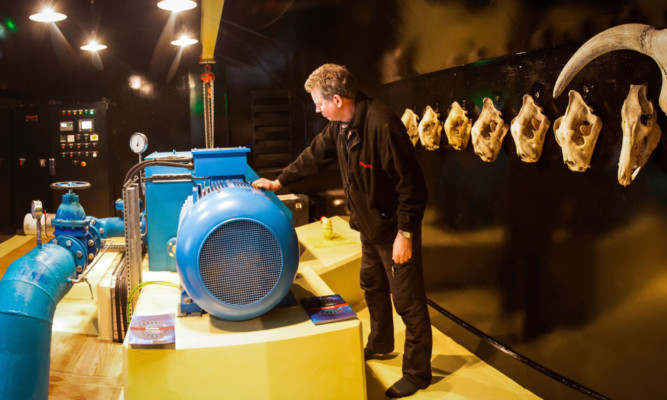The ingenuity of a previous generation has been harnessed to power one of Perthshire’s most historic buildings.
Thanks to a 100-year-old Edwardian hydro-electric scheme Blair Castle can now lay claim to being Scotland’s first completely self-sustaining castle.
Hundreds of thousands of litres of water pass through a turbine every hour, making electricity bills a thing of the past for the 13th-century building.
The £400,000 project which will save the castle around £40,000 per year was unveiled by Fergus Ewing, minister for business, energy and tourism, who praised the resurrection of an environmentally-friendly power source to the Highland Perthshire estate.
“It is fascinating to see a working hydroelectric scheme from a century ago remastered and utilised in this way,” he said.
“This hydroelectric scheme is a prime example of how businesses can make sustainable use of their natural resources without adversely affecting our stunning Scottish landscape while also creating for themselves a positive commercial advantage.
“Their efforts are to be highly commended and it is projects like Blair Castle’s hydroelectric scheme that places Scotland at the leading edge of green tourism.”
The hydro scheme, which was originally commissioned in 1908, will generate enough energy to power the entire castle.
Decommissioned in 1951 after the arrival of the National Grid, the castle decided to revisit the original hydro scheme to see if there was a way to develop an income stream to offset the increasing costs of maintaining such an ancient building.
A full consultancy team of hydro engineers, environmentalists and electrical specialists started construction of the recommissioned hydro last year.
After approaching Gilkes, manufacturer of the original 1908 turbines, and extensive specialist testing, the project team discovered the original 1908 pipe was in good working order because it had been full of water and continually in use since 1951 for the castle fire hydrant system.
As a Green Tourism Gold Award winner, it was important for Blair Castle that the hydro scheme was efficient and in keeping with its natural surroundings.
Jamie Troughton, husband of Sarah Troughton, head trustee of Atholl Estates, led the project team.
“We put a great deal of thought into how to refurbish the old power house,” he said.
“The turbine generates about 85 decibels when it is running, so with the help of acoustic engineers at the design stage the internal lining of the power house’s brick shell was designed to contain all the noise to ensure that the building is completely soundproof.
“This is a feature of which we are very proud.”
Andrew Bruce-Wootton, general manager at Atholl Estates, added: “The recommissioning of our very old but enduring hydroelectric scheme has been a real triumph for everyone involved in this project.”
